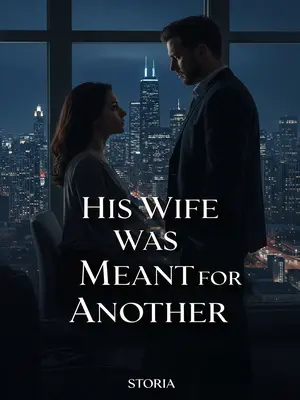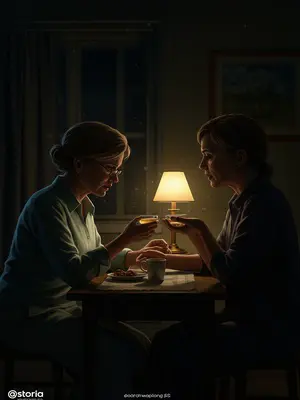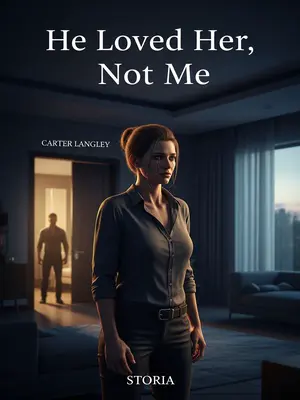Chapter 1: The Quiet Streets of Maplewood
No matter how disciplined a man thinks he is, sometimes desire walks in wearing a familiar face and turns his whole world upside down.
It's a lesson as old as time—and, as any crime writer or cop knows, it gets proven all over again with each new generation. In America, where temptation and tragedy seem to travel the same highways and backroads, it’s not just about what a person does, but who they can’t say no to.
But in Maplewood, Ohio, the fall of 2010 would prove that temptation and tragedy still walk hand in hand, even on the safest streets.
The first major murder case in Ohio that year, later included in American criminal investigation textbooks, brought this home in a way no one in Maplewood would forget.
They’d talk about it at police conferences and in criminal law classes at Ohio State: the way this single crime peeled back the layers of a quiet town. It would become a case study—an all-American tragedy, with every twist imaginable unfolding on a maple-lined street.
On October 26, 2010, police in Maplewood, Ohio, received a call from a man reporting his home had been burglarized.
Maplewood was the kind of Midwest suburb where folks still raked their own leaves and waved to the mail carrier. You could smell woodsmoke on the breeze, and every porch had a pumpkin with a candle guttering inside. Even so, the dispatcher at the station had learned never to take any call too lightly—not with how quickly things could turn.
At first, officers at the Maplewood police station assumed it was a routine theft and sent a patrol to the scene.
They jotted down the address, exchanged a knowing glance, and rolled their squad car down streets lined with fading pumpkins and yellowing lawns, expecting little more than another report for the file.
But when the officers checked the house, they found a young woman hidden inside the owner’s walk-in closet.
The closet was spacious, carrying the faint scent of lavender sachets and old cologne, with rows of shoes and winter coats lining the walls. It was the last place anyone expected to find something so horrifying.
Her sleep shirt was torn, leaving most of her fair skin exposed.
A shiver ran through the rookie cop’s spine as she saw the deep red stain on the pale cotton. She swallowed hard, remembering the warnings from her academy days—nothing ever prepares you for your first real body. In the muted light, the contrast was jarring—innocence and violence, side by side.
Her eyes were tightly shut, and a large patch of blood stained the back of her head.
She looked almost peaceful, if you didn’t look too long at the wound, or the way her hands curled slightly, as if she’d been reaching for help. The silence in the closet felt impossibly heavy. God, she looks so young, the officer thought, biting back the urge to close her eyes.
According to the caller, Thomas Reed, the woman was his wife, Emily Reed.
Thomas was still standing in the hallway, arms hanging at his sides, face pale as the paint on the wall. The sight of his wife’s body had drained all the color from him.
Tragically, the police confirmed at the scene that Emily Reed had been dead for some time; rigor mortis had already set in.
They didn’t need the coroner’s clock—her limbs were stiff, her body cool to the touch. Even the most hardened officer found themselves swallowing back a lump in their throat.
With homicide now apparent, the case was beyond the jurisdiction of the local station, so the county sheriff’s criminal investigation team quickly took over.
News traveled fast—soon, crime scene tape fluttered in the late afternoon breeze, and a pair of unmarked Chevys rolled up the curb. The neighborhood gathered on front porches, whispering over mugs of black coffee.
The team captain, David Harris, had over ten years of frontline detective experience.
He’d seen his share of domestic disputes and drunken brawls, but something about this case sent his instincts on high alert. Harris wasn’t just a badge—he was the kind of guy who noticed if you wore new boots to work, or if a neighbor’s porch light stayed off three nights in a row. Harris always kept a pack of gum in his pocket—said it helped him think when the details got muddy.
As soon as he entered the crime scene, he sensed something was off.
The air was thick, almost expectant, as if the walls themselves were holding their breath. Harris’s eyes swept over the living room, noting every overturned cushion and scattered photograph.
The room had been ransacked from top to bottom, which fit the pattern of a burglary. Yet, one thing was very unusual.
Pillows dumped on the floor, drawers yanked open, but it was all just...too neat. Not a single muddy footprint or scuff on the hardwood. He ran his thumb along the floorboards. Not a trace of dust, let alone blood or dirt.
The hardwood floor was spotless.
You could practically see your reflection in it. It looked like someone had given it a fresh polish, the kind you’d do before a house showing, not after a killing.
Could it be that after committing theft and murder, the killer stayed behind to clean the floor instead of bolting out in a panic?
Harris had seen plenty of desperate criminals, but he couldn’t imagine one scrubbing floors after murder. Usually, they left chaos in their wake, not Pine-Sol.
Normally, if a burglar breaks in and unexpectedly runs into someone at home, escalating from theft to murder, he’d be extremely nervous.
He’d grab whatever he could, maybe leave a bloody handprint or two. Fear makes people sloppy, and crime scenes messy. But not this one.
Getting out of there as fast as possible would be the criminal’s first instinct.
No one lingers after a killing—unless they’ve got nerves of steel, or something to hide. Harris filed that thought away for later.
At that moment, the county medical examiner reported to Harris.
She stepped over, notepad in hand, her latex gloves smudged with powder. She spoke quietly, out of respect for the dead, and maybe for the living, too.
Judging from the degree of rigor mortis, Emily Reed had died around midnight the previous night.
That meant she’d lain there for hours before anyone found her. Outside, the sun had come up and set again, the world going on, unaware.
The cause of death was strangulation. Before she was strangled, the back of her head had been struck by a blunt object.
A clean, deliberate blow—no hesitation, no warning. The kind of thing you see in cases where anger turns to murder in a split second.
Her sleep shirt was torn, suggesting the possibility of sexual assault. However, based on forensic evidence, it was determined that she had not been assaulted either before or after death.
The lab team double-checked, knowing how crucial such details could be. No DNA, no evidence of a struggle that went too far. The torn shirt seemed meant for shock value, or maybe misdirection.
Valuables such as the diamond earrings in her ears, the gold ring on her hand, and the necklace around her neck remained untouched.
Harris took note of the jewelry—real gold, not costume stuff. Even her purse sat open on the dresser, credit cards stacked neatly inside. That didn’t fit the burglar profile.
If the criminal was after money, why leave these behind?
It made less sense the more he thought about it. Any thief worth their salt would grab the shiny things first, especially when panic set in.
One of the detectives whistled low. "Either our thief’s an idiot, or he wasn’t after jewelry," he muttered.
Another suspicious detail: there were no signs of forced entry on the doors or windows, and no traces of climbing on the outer walls. The perpetrator most likely entered without resistance.
The locks weren’t scratched, the window screens were undisturbed. No footprints in the flowerbeds, either. Maplewood homes might not have fancy alarms, but folks kept their doors locked at night.
Furthermore, the cable TV in Emily Reed’s bedroom was paused in the middle of playing 'Desperate Housewives.'
Harris glanced at the TV, still aglow with the paused image of Wisteria Lane. The screen froze on a shot of Wisteria Lane—suburbia’s perfect lie. It was a show his wife loved, and the irony wasn’t lost on him—suburban secrets, murder behind white picket fences.
At this point, Harris began reconstructing the crime in his mind.
He paced the room, eyes narrowed, mentally filling in the blanks. He imagined Emily, curled up in bed with the TV remote, the house quiet except for the soft hum of dialogue from the screen.
Around midnight, Emily Reed was lying in bed watching TV when someone suddenly knocked at the door.
He pictured her pausing the show, annoyed at the late visitor, maybe pulling on a robe or slippers.
She opened the door and turned to walk back inside. The visitor struck her from behind, knocking her out, and then attempted to commit an indecent act.
The blow would have dropped her fast. The torn sleep shirt, the messy bedroom—Harris’s mind raced with possible motives.
During this, Emily regained consciousness. In a panic, the assailant strangled her to death, then hid her body in the closet.
He pictured the assailant’s hands tightening in fear and rage, and the hurried decision to shove her body out of sight—out of mind, as if that could undo what had been done.
After the murder, the killer searched the house for valuables, cleaned the floor, and then escaped…
It was all so methodical. Harris wondered if the killer wiped the floor out of habit, or just to buy time—make it look less like murder, more like a botched theft.
This was the reconstruction based on the scene evidence.
He explained his theory to the team, outlining each step on a yellow legal pad, but his gut was already telling him something didn’t fit.
But if this were truly a burglary or home invasion, too many things didn’t add up.
Every time he tried to fit the pieces together, they left gaps. Too clean, too staged, too...unlikely for a panic-driven thief.
Why would Emily Reed open the door for the killer in the middle of the night?
Most folks wouldn’t even get out of bed for a late-night knock unless they recognized the voice, or trusted the person on the other side.
Did she know the person?
That was the million-dollar question. Harris’s mind flashed through faces—friends, relatives, neighbors.
If the killer was after money, why choose a time when someone was home at night? Wouldn’t it be safer during the day when the residents were out?
Maplewood had its share of daytime break-ins—thieves who waited until the streets were empty, kids at school, parents at work. This didn’t fit the pattern.
Also, why enter the house to kill first, then search for valuables, and finally clean up the scene?
It felt backward, like someone playing at being a burglar, not actually trying to get away with theft.
All these inconsistencies strongly suggested that this was not a murder for money.
The more he talked it out with the team, the more convinced Harris became. Something personal was at play.













